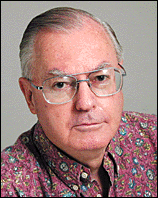


The Rising East
Cranky cabbies indicate
better times for ThailandBangkok >> Taxi drivers in this frenetic city provide perhaps the best evidence that the economy of Thailand, which went into a nose-dive five years ago, is well started on a recovery. Most taxi drivers here are just plain nasty because they are in such demand they need not be considerate of customers. They refuse to accept passengers, demand extra payment and occasionally throw riders out if the traffic gets too heavy on a long haul.
When the Thai currency crashed in July 1997, the traffic for which Bangkok is notorious suddenly eased up. Longtime residents say it actually became pleasant to move around the city on business or for pleasure. With that, however, Thailand's promise of being the next Asian "tiger," joining South Korea, Taiwan, Hong Kong and Singapore on the way to prosperity, evaporated.
This city is where the "Asian contagion" of economic distress started, then headed north to South Korea and south to Indonesia. Today, Thailand has bounced back, although not to the income and growth that Thais enjoyed before. Most forecasts say that by late this year or certainly by this time next year, Thailand will be on the upswing. "This affects everything here," said a diplomat, "from military spending to the man in the street."
Most of the rest of Asia also is recovering, with South Korea leading the pack while Indonesia lags behind. The two biggest economies in East Asia, those of Japan and China, have not been much affected because Japan has its own endemic problems and China has isolated itself from the contagion.
The authoritative Economic Intelligence Unit of London reported recently that Asia's recovery "is gaining ground and should accelerate over the next few quarters on the back of rising demand from the developed world, especially the U.S."
For Americans, this is good news. In the first quarter of 1997, before the crash, the United States ran a $24.3 billion deficit in trade with Asia. That rose to a peak of $46.6 billion in the first quarter of 2000 as Asian imports poured into the United States, while American exports to those stricken economies fell. The deficit has eased a bit, to $44 billion in the first quarter of this year.
Beyond the surly taxi drivers are other signs of recovery. A stroll through the Sunday market near the river that runs through Bangkok, where working people buy the everyday things of life, finds Thais spending on toys for their children, tapes and DVDs for their music collections, and cold drinks to slake thirsts brought on by searing heat. A Thai journalist says better wages and lower prices have enabled families to have more fruit.
Then there are the formal indicators of economic recovery. The Thai stock market recently hit its highest point since 1997, and the Far East Economic Review reported: "Driven by a private consumption-led economic recovery, the good times are rolling on the Stock Exchange of Thailand again."
The Thai currency, the baht, traded at 25 to the U.S. dollar before it collapsed, falling to 58 to the dollar. It has recovered to 40 to the dollar, meaning an American visitor will get 40 baht for every dollar put on the counter. It also means Thai traders need put up fewer baht to buy the dollars with which to settle imports bills.
Foreign investment has begun to flow back into Thailand, especially from Japan, the largest overseas investor here with about 2,500 investments or joint ventures. NSK Bearings Manufacturing (Thailand), which is a 75-25 percent joint venture with Siam Motors, has just opened a new plant outside of Bangkok.
Even so, The Nation, a leading newspaper, warns in an editorial: "Light, but not yet the tunnel's end." The paper asserted that the government "has won an initial economic battle but has yet to win the economic war." The key question, the editorial argued, "is how to sustain an economic growth rate of 5-6 percent, which is Thailand's real potential."
Outside of Bangkok, on the way to the international airport, row upon row of concrete pillars intended to carry an elevated highway march across the landscape as mute testimony that the editorial may be right. The construction project was halted in 1997 when woes befell the economy -- and there it stands with no known plans to revive it.
Richard Halloran is a former correspondent
for The New York Times in Asia and a former editorial
director of the Star-Bulletin. His column appears Sundays.
He can be reached by e-mail at rhalloran@starbulletin.com